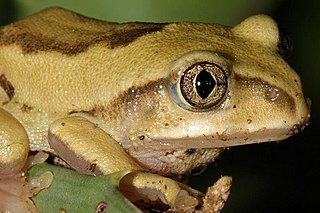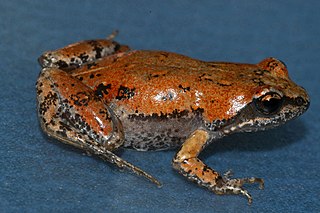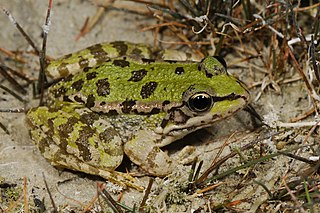
Leptopelis mossambicus, the brown-backed tree frog, Mozambique tree frog or Mossambique forest treefrog, is a species of frog in the family Arthroleptidae found in Eswatini, Malawi, Mozambique, South Africa, Zimbabwe, and possibly Botswana. Its natural habitats are dry savanna, moist savanna, subtropical or tropical moist shrubland, subtropical or tropical dry lowland grasslands, subtropical or tropical seasonally wet or flooded lowland grasslands, swamps, freshwater marshes, and intermittent freshwater marshes. It is threatened by habitat loss.

Pleurodema bufoninum, the large four-eyed frog, is a species of frog in the family Leptodactylidae. It is found in Argentina and Chile. Its natural habitats are subantarctic forests, temperate forests, subantarctic shrubland, temperate shrubland, subtropical or tropical dry shrubland, subantarctic grassland, temperate grassland, intermittent rivers, swamps, intermittent freshwater marshes, arable land, rural gardens, ponds, and open excavations. The common name "four-eyed frog" refers to two inguinal poison glands that resemble eyes. When threatened, the frog lowers its head and raises its rear. When the frog adopts this posture, the poison glands are also raised toward the predator. The predator may also confuse the frog's raised posterior for the head of a larger animal.
The spotted rubber frog is a species of frog in the family Microhylidae. It is found in Angola, Democratic Republic of the Congo, Namibia, Zambia, possibly Botswana, possibly Tanzania, and possibly Zimbabwe. Its natural habitats are dry savanna, moist savanna, subtropical or tropical dry shrubland, intermittent freshwater lakes, and intermittent freshwater marshes.

The Boettger's dainty frog or common caco is a species of frog in the family Pyxicephalidae. It is found in Botswana, Ethiopia, Kenya, Lesotho, Mozambique, Namibia, Rwanda, South Africa, Eswatini, Tanzania, Zambia, Zimbabwe, possibly Angola, and possibly Uganda. Its natural habitats are dry savanna, moist savanna, subtropical or tropical dry shrubland, subtropical or tropical moist shrubland, subtropical or tropical dry lowland grassland, subtropical or tropical seasonally wet or flooded lowland grassland, subtropical or tropical high-altitude grassland, swampland, intermittent freshwater lakes, intermittent freshwater marshes, arable land, pastureland, plantations, rural gardens, ponds, seasonally flooded agricultural land, and canals and ditches.

The Cape caco or Cape dainty frog is a species of frog in the family Pyxicephalidae. It is endemic to South Africa. Its natural habitats are Mediterranean-type shrubby vegetation, subtropical or tropical dry lowland grassland, freshwater marshes, intermittent freshwater marshes, arable land, pastureland, and canals and ditches. It is threatened by habitat loss.
The Katanga caco or Katanga metal frog is a species of frog in the family Pyxicephalidae, endemic to Democratic Republic of the Congo. Its natural habitats are moist savanna, subtropical or tropical seasonally wet or flooded lowland grassland, intermittent rivers, swampland, and intermittent freshwater marshes.

The Namaqua caco or Namaqua dainty frog is a species of frog in the family Pyxicephalidae found in Namibia and South Africa. Its natural habitats are subtropical or tropical dry shrubland, intermittent rivers, intermittent freshwater marshes, freshwater springs, and rocky areas. It is threatened by habitat loss.

The bronze caco, or bronze dainty frog, is a species of frog in the family Pyxicephalidae found in South Africa, Eswatini, and possibly Lesotho and Mozambique.

The mountain caco or small dainty frog is a frog species in the family Pyxicephalidae, found in Eswatini, Lesotho and South Africa. Its natural habitats are subtropical or tropical moist montane forest, subtropical or tropical seasonally wet or flooded lowland grassland, subtropical or tropical high-altitude grassland, rivers, intermittent rivers, swampland, freshwater marshes, intermittent freshwater marshes, pastureland, plantations, ponds, and canals and ditches.

The flat caco, flat dainty frog, or smooth dainty frog is a species of frog in the family Pyxicephalidae, endemic to South Africa. Its natural habitats are Mediterranean-type shrubby vegetation, subtropical or tropical seasonally wet or flooded lowland grassland, intermittent rivers, intermittent freshwater marshes, arable land, pastureland, rural gardens, urban areas, ponds, irrigated land, canals and ditches, and introduced vegetation.
Poynton's caco or Poynton's dainty frog is a species of frog in the family Pyxicephalidae, endemic to South Africa.

The striped caco or striped metal frog is a species of frog in the family Pyxicephalidae, found in Lesotho and South Africa, and possibly Mozambique and Eswatini. Its natural habitats are subtropical or tropical moist shrubland, subtropical or tropical seasonally wet or flooded lowland grassland, subtropical or tropical high-altitude grassland, rivers, and swampland. It is threatened by habitat loss.

The green puddle frog, rough-skinned floating frog, pearly skin puddle frog, or pointed-tongued floating frog is a species of frog in the family Dicroglossidae. It is found in Bangladesh, Cambodia, China, Hong Kong, India, Indonesia, Laos, Malaysia, Myanmar, Thailand, Vietnam, and possibly Nepal.

Ptychadena bibroni is a species of frog in the family Ptychadenidae. It is found in Burkina Faso, Cameroon, Central African Republic, Chad, Democratic Republic of the Congo, Ivory Coast, Gambia, Ghana, Guinea, Liberia, Mali, Nigeria, Senegal, Sierra Leone, Togo, possibly Benin, possibly Guinea-Bissau, and possibly Sudan. Its natural habitats are dry savanna, moist savanna, intermittent freshwater marshes, rural gardens, heavily degraded former forest, and canals and ditches.
Ptychadena cooperi is a species of frog in the family Ptychadenidae. It is endemic to Ethiopia.
Ptychadena neumanni is a species of frog in the family Ptychadenidae. It is endemic to Ethiopia.

The Schilluk ridged frog is a species of frog in the family Ptychadenidae. It is found in Angola, Burkina Faso, Cameroon, Democratic Republic of the Congo, Egypt, Eritrea, Ethiopia, Ghana, Kenya, Malawi, Mozambique, Senegal, Somalia, Sudan, and Tanzania. Its natural habitats are dry savanna, moist savanna, subtropical or tropical dry shrubland, subtropical or tropical dry lowland grassland, subtropical or tropical seasonally wet or flooded lowland grassland, rivers, freshwater lakes, freshwater marshes, intermittent freshwater marshes, arable land, ponds, seasonally flooded agricultural land, and canals and ditches.

The Cretan frog is a species of frog in the family Ranidae. It is endemic to Greece.

The Perez's frog, also known as Iberian waterfrog, Iberian green frog or Coruna frog, is a species of frog in the family Ranidae. It is native to southern France, Portugal, Spain, and has been introduced to the Canary and Balearic Islands, Madeira, the United Kingdom, and the Azores. In the Iberian Peninsula it is widespread and common.

Vaillant's frog is a species of frog in the family Ranidae found in Central America. Its natural habitats are subtropical or tropical dry forests, subtropical or tropical moist lowland forests, subtropical or tropical swamps, rivers, swamps, freshwater lakes, intermittent freshwater lakes, freshwater marshes, intermittent freshwater marshes, rural gardens, heavily degraded former forests, water storage areas, ponds, and canals and ditches.
















